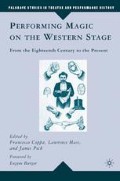Abstract
Situating the words magic and disability together conjures images of cure, of bodily disassembling and reassembling, of bondage and escape. Consider the classic act of sawing a woman in half and then making her whole again, or symbolically killing her by penetrating her body with a series of knives, only to assist her energetic and youthfully luscious body out of the box moments later. Consider also Houdini’s impossible escapes from confinement. Much current stage magic relies on a narrative of disabling captivity, followed by magical release and transformation. These images address societal anxieties about a loss of personal control and individual desire for power to escape bodily deterioration and death. Witnessing the magician disabling himself or someone else and then, through extraordinary cleverness, undoing it implies that the magician can dictate destiny. He thus assuages fears of disability and death.
Karen Dearborn is Professor and founding director of dance at Muhlenberg College. Previously, Dearborn served for ten years on the faculty of the National Theatre of the Deaf Professional Summer School. Dearborn analyzes the work of two contemporary magicians, Jim Passé and René Lavand, both of whom are disabled; Passé uses a wheelchair, and Lavand (a master of card manipulation) has only one hand. Dearborn’s analysis draws upon disability studies and gender studies. Dearborn inquires into the ways performances by Passé and Lavand represent disability and masculinity. How do these magicians construct the relationship between the disabled body and masculine identity? How do they use magic to disrupt, affirm, manipulate, and transform societal beliefs about disability and gender?
Access this chapter
Tax calculation will be finalised at checkout
Purchases are for personal use only
Preview
Unable to display preview. Download preview PDF.
Works Cited
Davis, Lennard J. Enforcing Normalcy. London: Verso, 1995.
—. “Identity Politics, Disability, and Culture.” Handbook of Disability Studies. Ed. Gary Albrecht, Katherine Seelman, and Michael Bury. Thousand Oaks, CA: Sage Publications, 2001. 535–545.
—. Bending over Backwards: Disability, Dismodernism and Other Difficult Positions. New York: New York UP, 2002.
Davis, Lennard J. ed. The Disability Studies Reader. New York: Routledge, 1997.
Garland Thomson, Rosemarie. Extraordinary Bodies: Figuring Physical Disability in American Culture and Literature. New York: Columbia UP, 1997.
—. “The Politics of Staring: Visual Rhetorics of Disability in Popular Photography.” In Disability Studies: Enabling the Humanities. Ed. Sharon L. Snyder, Brenda Jo Bruggeman, and Rosemarie Garland-Thomson. New York: Modern Language Association of America, 2002. 56–75.
Hass, Lawrence. Personal communication, 2007.
Kaufman, Richard. Preface to The Mysteries of My Life. By Richard Kaufman and Rene Lavand. Washington, DC: Kaufman, 1998. 11.
Kaufman, Richard and René Lavand. The Mysteries ofMy Life. Washington, DC: Kaufman, 1998.
Kirkham, P. “Loving Men: Frank Borzage Charles Farrell and the Reconstruction of Masculinity.” In Me jane: Masculinity, Movies and Women. Ed. P. Kirkham and J. Thumim. New York: St. Martin’s P, 1995. 94–112.
Kuppers, Petra. Disability and Contemporary Performance: Bodies on Edge. New York: Routledge, 2003.
Lavand, René. Magic from the Soul. Pasadena, CA: Mike Caveney’s Magic Words, 1993.
—. “It Can’t Be Done Any Slower.” World’s GreatestMagic II. NBC. Hosted by Alan Thicke. November 22, 1995.
—. “A Magical Conversation with Rene Lavand.” Public talk, Muhlenberg College, Allentown, PA. October 24, 2002.
Longmore, Paul, K. Why I Burned My Book and Other Essays on Disability. Philadelphia: Temple UP, 2003.
Manderson, Lenore and Susan Peake. “Men in Motion: Disability and the Performance of Masculinity.” Bodies in Commotion: Disability and Performance. Ed. Carrie Sandahl and Philip Auslander. Ann Arbor: U of Michigan P, 2005. 230–242.
Murphy, Robert. The Body Silent. New York: Holt, 1987.
Passé, Jim. “The Magic of Jim Passe.” August 8, 2007, http://www.magicofjimpasse. com:16080 /index2.php.
—. “Paradox Sphere.” World’s GreatestMagic V. NBC. Hosted by John Ritter and John Gabriel. November 25, 1998.
Powrie, Phil, Ann Davies, and Bruce Babington, eds. The Trouble with Men: Masculinities in European and Hollywood Cinema. London: Wallflower P, 2004.
Schneider, Rebecca. The Explicit Body in Performance. New York: Routledge, 1997.
Smith, Aaron. “The Magic Depot.” August 8, 2007, http://www.magic.org/store/product_info.php?products_id=438.
Smith, John E. “It’s a Life, Not a Feel-Good Moment.” Washington Post January 9, 2006.
Wright, Beatrice. Physical Disability: A Psychosocial Approach. New York: Harper and Row, 1983.
Editor information
Copyright information
© 2008 Francesca Coppa, Lawrence Hass, and James Peck
About this chapter
Cite this chapter
Dearborn, K. (2008). Intersecting Illusions: Performing Magic, Disability, and Gender. In: Coppa, F., Hass, L., Peck, J. (eds) Performing Magic on the Western Stage. Palgrave Studies in Theatre and Performance History. Palgrave Macmillan, New York. https://doi.org/10.1057/9780230617124_9
Download citation
DOI: https://doi.org/10.1057/9780230617124_9
Publisher Name: Palgrave Macmillan, New York
Print ISBN: 978-1-349-37464-9
Online ISBN: 978-0-230-61712-4
eBook Packages: Palgrave Literature & Performing Arts CollectionLiterature, Cultural and Media Studies (R0)

